check LOTUS ELISE 2005 Owners Manual
[x] Cancel search | Manufacturer: LOTUS, Model Year: 2005, Model line: ELISE, Model: LOTUS ELISE 2005Pages: 205, PDF Size: 4.51 MB
Page 4 of 205
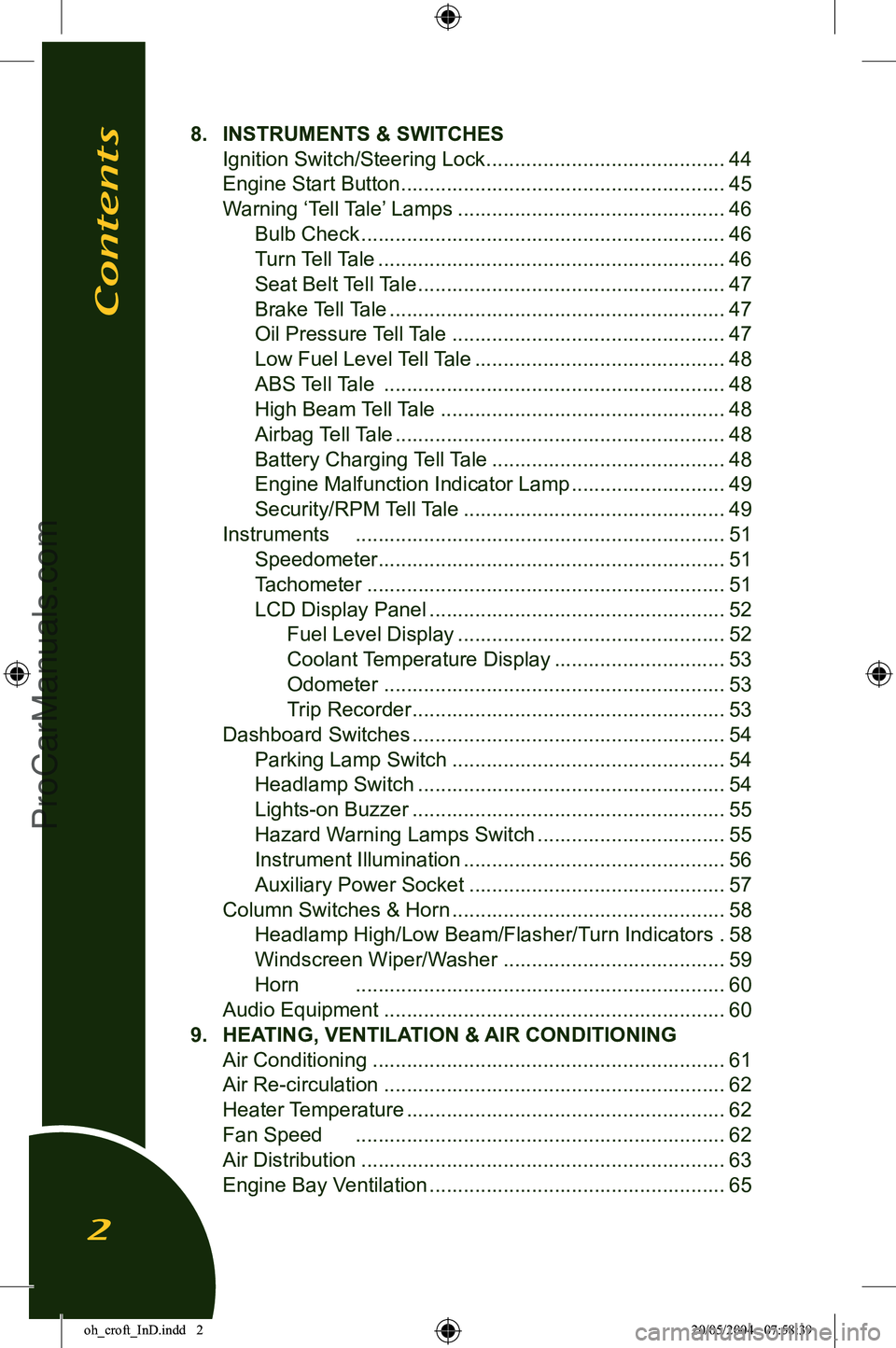
8. INSTRUMENTS & SWITCHES
Ignition Switch/Steering Lock ..........................................
44
Engine Start Button .........................................................
45
Warning āTell Taleā Lamps ...............................................
46
Bulb Check ................................................................
46
Turn Tell Tale .............................................................
46
Seat Belt Tell Tale ......................................................
47
Brake Tell Tale ...........................................................
47
Oil Pressure Tell Tale ................................................
47
Low Fuel Level Tell Tale ............................................
48
ABS Tell Tale ............................................................
48
High Beam Tell Tale ..................................................
48
Airbag Tell Tale ..........................................................
48
Battery Charging Tell Tale .........................................
48
Engine Malfunction Indicator Lamp ...........................
49
Security/RPM Tell Tale ..............................................
49
Instruments .................................................................
51
Speedometer .............................................................
51
Tachometer ...............................................................
51
LCD Display Panel ....................................................
52
Fuel Level Display ...............................................
52
Coolant Temperature Display ..............................
53
Odometer ............................................................
53
Trip Recorder .......................................................
53
Dashboard Switches .......................................................
54
Parking Lamp Switch ................................................
54
Headlamp Switch ......................................................
54
Lights-on Buzzer .......................................................
55
Hazard Warning Lamps Switch .................................
55
Instrument Illumination ..............................................
56
Auxiliary Power Socket .............................................
57
Column Switches & Horn ................................................
58
Headlamp High/Low Beam/Flasher/Turn Indicators .
58
Windscreen Wiper/Washer .......................................
59
Horn .................................................................
60
Audio Equipment ............................................................
60
9. HEATING, VENTILATION & AIR CONDITIONING
Air Conditioning ..............................................................
61
Air Re-circulation ............................................................
62
Heater Temperature ........................................................
62
Fan Speed .................................................................
62
Air Distribution ................................................................
63
Engine Bay Ventilation ....................................................
65
Contents
2
oh_croft_InD.indd 220/05/2004 07:58:39ProCarManuals.com
Page 5 of 205
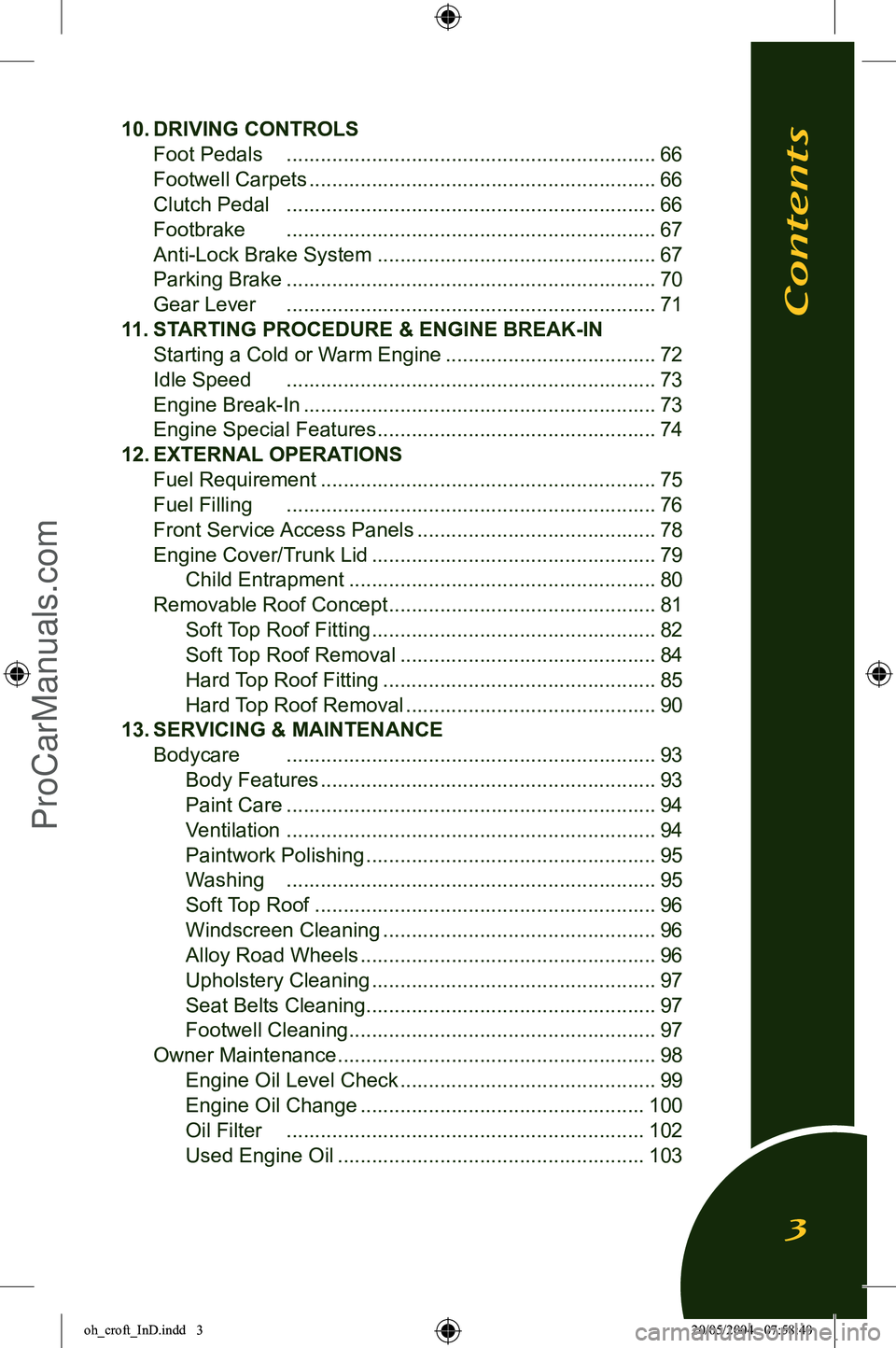
10. DRIVING CONTROLS
Foot Pedals .................................................................
66
Footwell Carpets .............................................................
66
Clutch Pedal .................................................................
66
Footbrake .................................................................
67
Anti-Lock Brake System .................................................
67
Parking Brake .................................................................
70
Gear Lever .................................................................
71
11. STARTING PROCEDURE & ENGINE BREAK-IN
Starting a Cold or Warm Engine .....................................
72
Idle Speed .................................................................
73
Engine Break-In ..............................................................
73
Engine Special Features .................................................
74
12. EXTERNAL OPERATIONS
Fuel Requirement ...........................................................
75
Fuel Filling .................................................................
76
Front Service Access Panels ..........................................
78
Engine Cover/Trunk Lid ..................................................
79
Child Entrapment ......................................................
80
Removable Roof Concept ...............................................
81
Soft Top Roof Fitting ..................................................
82
Soft Top Roof Removal .............................................
84
Hard Top Roof Fitting ................................................
85
Hard Top Roof Removal ............................................
90
13. SERVICING & MAINTENANCE
Bodycare .................................................................
93
B
ody Features ...........................................................93
Paint Care .................................................................
94
Ventilation .................................................................
94
Paintwork Polishing ...................................................
95
Washing .................................................................
95
Soft Top Roof ............................................................
96
Windscreen Cleaning ................................................
96
Alloy Road Wheels ....................................................
96
Upholstery Cleaning ..................................................
97
Seat Belts Cleaning ...................................................
97
Footwell Cleaning ......................................................
97
Owner Maintenance ........................................................
98
Engine Oil Level Check .............................................
99
Engine Oil Change ..................................................
100
Oil Filter ...............................................................
102
Used Engine Oil ......................................................
103
Contents
3
oh_croft_InD.indd 320/05/2004 07:58:40ProCarManuals.com
Page 10 of 205
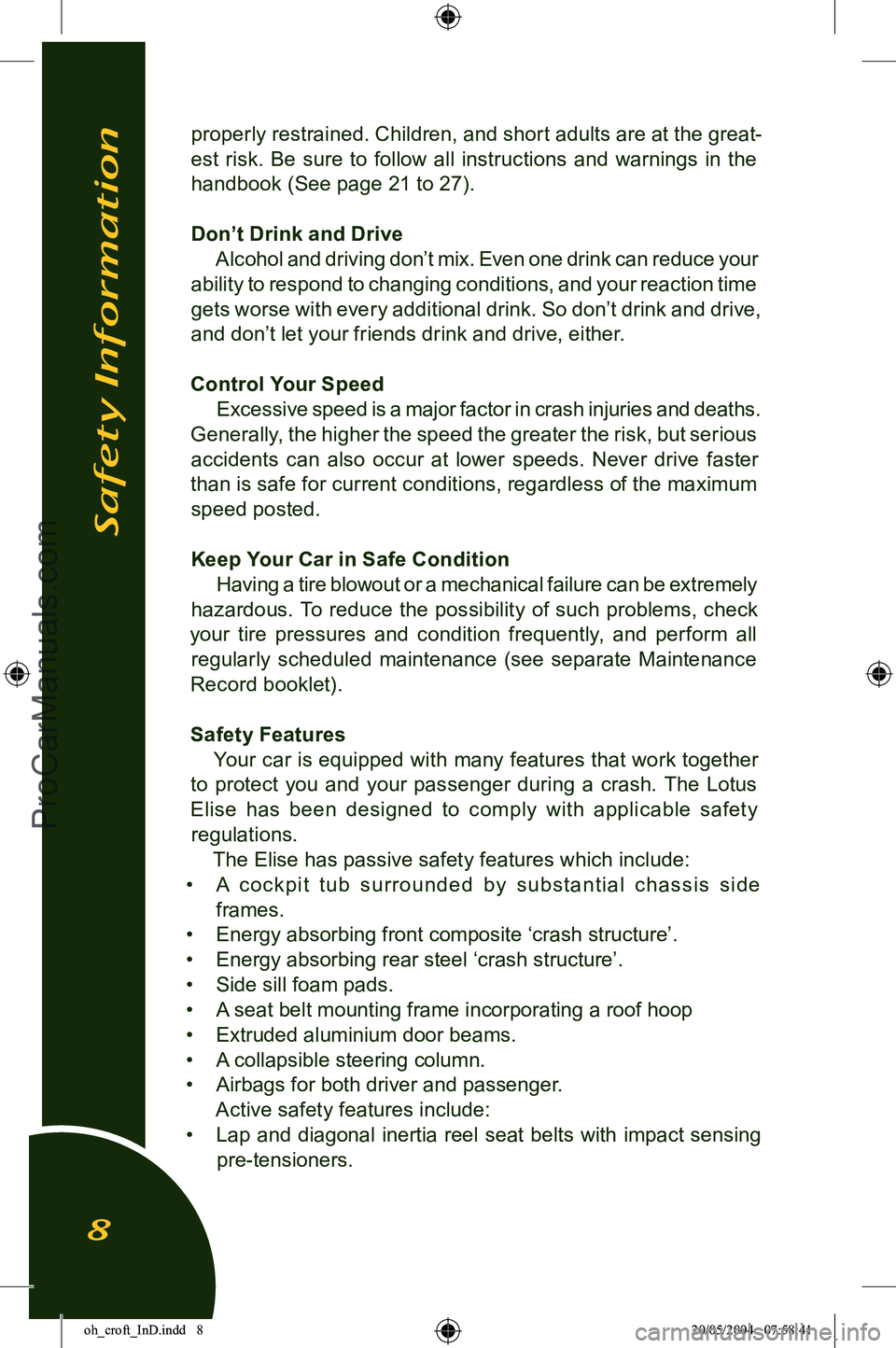
properly restrained. Children, and short adults are at the great-
est risk. Be sure to follow all instructions and warnings in the handbook (See page 21 to 27).
Donāt Drink and Drive Alcohol and driving donāt mix. Even one drink can reduce your
ability to respond to changing conditions, and your reaction time
gets worse with every additional drink. So donāt drink and drive,
and donāt let your friends drink and drive, either.
Control Your Speed Excessive speed is a major factor in crash injuries and deaths.
Generally, the higher the speed the greater the risk, but serious accidents can also occur at lower speeds. Never drive faster
than is safe for current conditions, regardless of the maximum speed posted.
Keep Your Car in Safe Condition Having a tire blowout or a mechanical failure can be extremely
hazardous. To reduce the possibility of such problems, check
your tire pressures and condition frequently, and perform all
regularly scheduled maintenance (see separate Maintenance
Record booklet).
Safety Features Your car is equipped with many features that work together
to protect you and your passenger during a crash. The Lotus Elise has been designed to comply with applicable safety regulations. The Elise has passive safety features which include:
ā¢ A cockpit tub surrounded by substantial chassis side
frames.
ā¢ Energy absorbing front
composite ācrash structureā.
ā¢ Energy absorbing rear steel
ācrash structureā.
ā¢ Side sill foam pads.
ā¢ A seat belt mounting frame incorporating a roof hoop
ā¢ Extruded aluminium door beams.
ā¢ A collapsible steering column.
ā¢ Airbags for both driver and passenger. Active safety features include:
ā¢ Lap and diagonal inertia reel seat belts with impact sensing
pre-tensioners.
Safety Information
8
oh_croft_InD.indd 820/05/2004 07:58:41ProCarManuals.com
Page 14 of 205
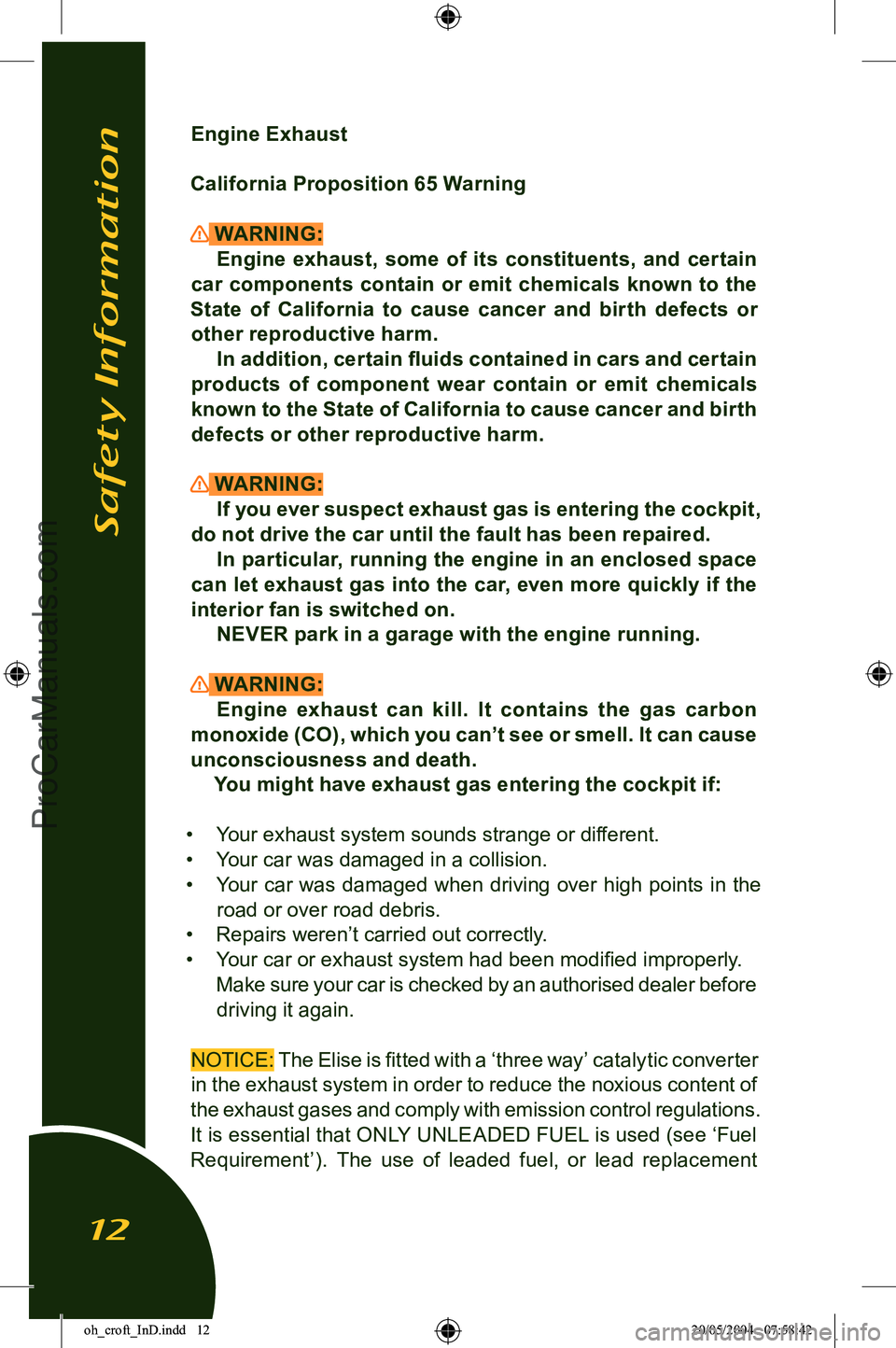
Engine Exhaust
California Proposition 65 Warning
WARNING: Engine exhaust, some of its constituents, and certain
car components contain or emit chemicals known to the
State of California to cause cancer and birth defects or other reproductive harm. In addition, certain ļ¬uids contained in cars and certain
products of component wear contain or emit chemicals
known to the State of California to cause cancer and birth
defects or other reproductive harm.
WARNING: If you ever suspect exhaust gas is entering the cockpit,
do not drive the car until the fault has been repaired.
In particular, running the engine in an enclosed space
can let exhaust gas into the car, even more quickly if the interior fan is switched on. NEVER park in a garage with the engine running.
WARNING:Engine exhaust can kill. It contains the gas carbon
monoxide (CO), which you canāt see or smell. It can cause
unconsciousness and death. You might have exhaust gas entering the cockpit if:
ā¢ Your exhaust system sounds strange or different.
ā¢ Your car was damaged in a collision.
ā¢ Your car was damaged when driving over high points in the
road or over road debris.
ā¢ Repairs werenāt carried out correctly.
ā¢ Your car or exhaust system had been modiļ¬ed improperly.
Make sure your car is checked by an authorised dealer before
driving it again.
NOTICE: The Elise is ļ¬tted with a āthree wayā catalytic converter
in the exhaust system in order to reduce the noxious content of
the exhaust gases and comply with emission control regulations.
It is essential that ONLY UNLEADED FUEL is used (see āFuel Requirementā). The use of leaded fuel, or lead replacement
Safety Information
12
oh_croft_InD.indd 1220/05/2004 07:58:42ProCarManuals.com
Page 15 of 205

petrol (LRP), will cause irreversible contamination of the pre-
cious metal catalysts and of the exhaust gas sensor used by the
computer controlled engine management system.
It is important that the Maintenance Schedule (see separate
booklet) is followed at the speciļ¬ed time and distance intervals
(this is a requirement of the warranty), and that the car is kept in proper operating condition. Failure to do so may result not only
in a loss of fuel economy and emission control, but may cause damage to the catalytic converter.
WARNING:
ā¢ If the engine malfunctions in any way (e.g by a change in sound) have the fault diagnosed and repaired promptly.
Continuing to drive the car with an engine misļ¬re could cause the catalytic converter to overheat, with possible heat damage to other car components, and an engine bay
ļ¬re. Operation of the āMalfunction Indicator Lampā (MIL)
is fully described later in this handbook on page 49.
ā¢ DO NOT park or drive the car in areas where combustible material, such as dry grass or leaves, could come into
contact with the hot exhaust system. Under certain wind and weather conditions a grass ļ¬re could be initiated.
ā¢ DO NOT tamper with any electrical components with the battery connected. You could receive an electric shock
from the spark plug coils or initiate a car ļ¬re.
ā¢ DO NOT check or adjust any engine bay equipment with the engine running. Failure to comply with this may result
in you or your clothing becoming trapped.
ā¢ DO NOT use the car if a fuel leak is suspected, as may be indicated by a persistent smell of fuel. Have the fault
diagnosed and rectiļ¬ed without delay. A fuel leak may result in a ļ¬re or explosion.
ā¢ DO NOT touch or approach, any part of a hot exhaust
system. Failure to comply with this may result in you
receiving severe burns.
ā¢ DO NOT allow servicing or repairs to be carried out by unskilled persons as this may adversely affect the han
-
dling and safety features on your car. Lotus dealers have
trained staff who are best qualiļ¬ed to maintain your car
to the correct speciļ¬cation.
Safety Information
13
oh_croft_InD.indd 1320/05/2004 07:58:42ProCarManuals.com
Page 16 of 205
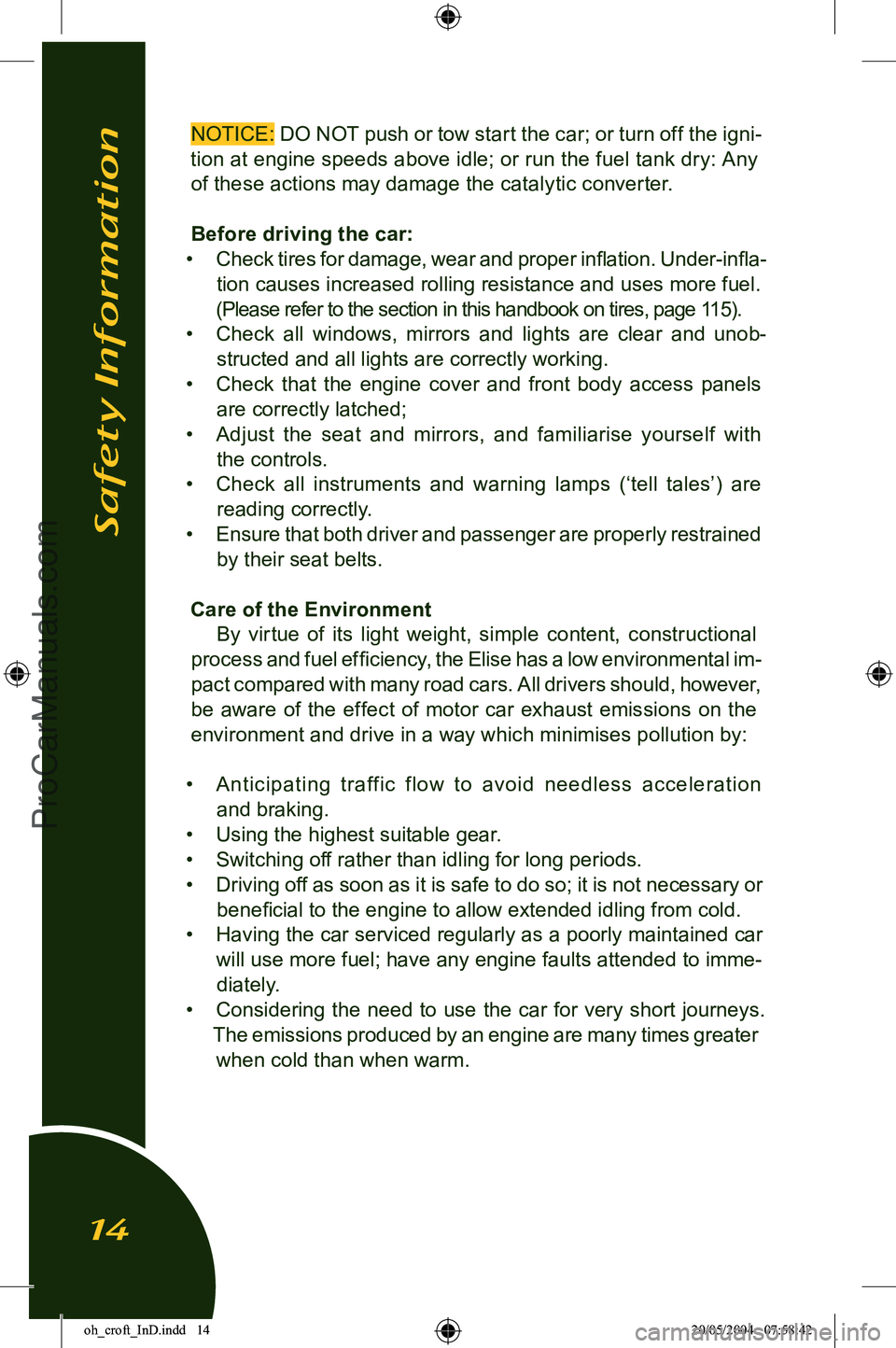
NOTICE: DO NOT push or tow start the car; or turn off the igni-
tion at engine speeds above idle; or run the fuel tank dry: Any of these actions may damage the catalytic converter.
Before driving the car:
ā¢ Check tires for damage, wear and proper inļ¬ation.
Under-inļ¬a-
tion causes increased rolling resistance and uses more fuel.
(Please refer to the section in this handbook on tires, page 115).
ā¢ Check all windows, mirrors and lights are clear and unob
-
structed and all lights are correctly working.
ā¢ Check that the engine cover and front body access panels
are correctly latched;
ā¢ Adjust the seat and mirrors, and familiarise yourself with
the controls.
ā¢ Check all instruments and warning lamps (ātell talesā) are reading correctly.
ā¢ Ensure that both driver and passenger are properly restrained
by their seat belts.
Care of the Environment By virtue of its light weight, simple content, constructional
process and fuel efļ¬ciency, the Elise has a low environmental im
-
pact compared with many road cars. All drivers should, however,
be aware of the effect of motor car exhaust emissions on the
environment and drive in a way which minimises pollution by:
ā¢ Anticipating traffic flow to avoid needless acceleration
and braking.
ā¢ Using the highest suitable gear.
ā¢ Switching off rather than idling for long periods.
ā¢ Driving off as soon as it is safe to do so; it is not necessary or beneļ¬cial to the engine to allow extended idling from cold.
ā¢ Having the car serviced regularly as a poorly maintained car will use more fuel; have any engine faults attended to imme
-
diately.
ā¢ Considering the need to use the car for very short journeys.
The emissions produced by an engine are many times greater
when cold than when warm.
Safety Information
14
oh_croft_InD.indd 1420/05/2004 07:58:42ProCarManuals.com
Page 21 of 205
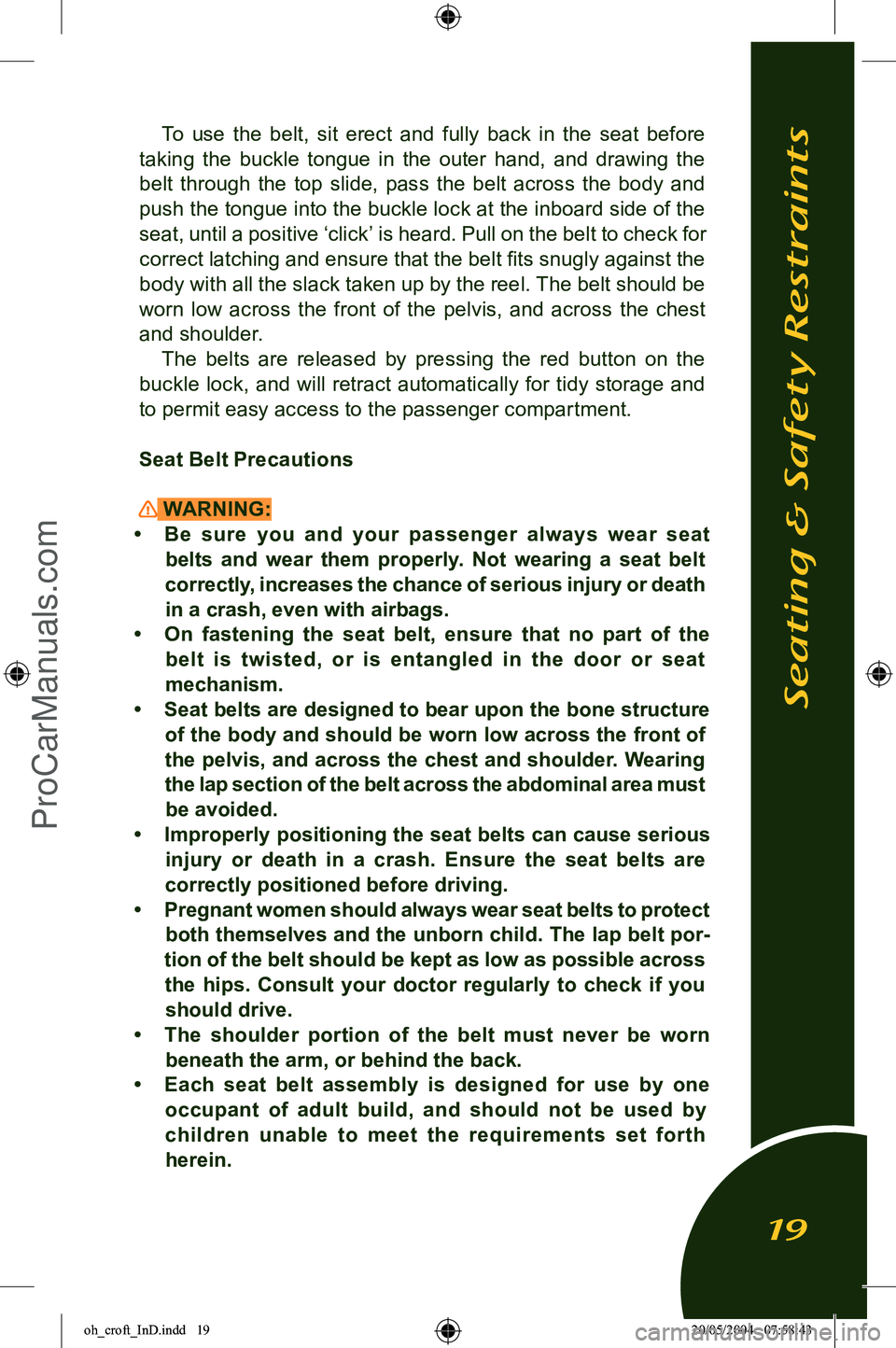
To use the belt, sit erect and fully back in the seat before
taking the buckle tongue in the outer hand, and drawing the belt through the top slide, pass the belt across the body and
push the tongue into the buckle lock at the inboard side of the
seat, until a positive āclickā is heard. Pull on the belt to check for correct latching and ensure that the belt ļ¬ts snugly against the body with all the slack taken up by the reel. The belt should be
worn low across the front of the pelvis, and across the chest and shoulder. The belts are released by pressing the red button on the
buckle lock, and will retract automatically for tidy storage and
to permit easy access to the passenger compartment.
Seat Belt Precautions
WARNING:
ā¢ Be sure you and your passenger always wear seat belts and wear them properly. Not wearing a seat belt
correctly, increases the chance of serious injury or death
in a crash, even with airbags.
ā¢ On fastening the seat belt, ensure that no part of the belt is twisted, or is entangled in the door or seat
mechanism.
ā¢ Seat belts are designed to bear upon the bone structure
of the body and should be worn low across the front of
the pelvis, and across the chest and shoulder. Wearing
the lap section of the belt across the abdominal area must be avoided.
ā¢ Improperly positioning the seat belts can cause serious injury or death in a crash. Ensure the seat belts are
correctly positioned before driving.
ā¢ Pregnant women should always wear seat belts to protect
both themselves and the unborn child. The lap belt por
-
tion of the belt should be kept as low as possible across the hips. Consult your doctor regularly to check if you
should drive.
ā¢ The shoulder portion of the belt must never be worn beneath the arm, or behind the back.
ā¢ Each seat belt assembly is designed for use by one
occupant of adult build, and should not be used by
children unable to meet the requirements set forth
herein.
Seating & Safety Restraints
19
oh_croft_InD.indd 1920/05/2004 07:58:43ProCarManuals.com
Page 22 of 205
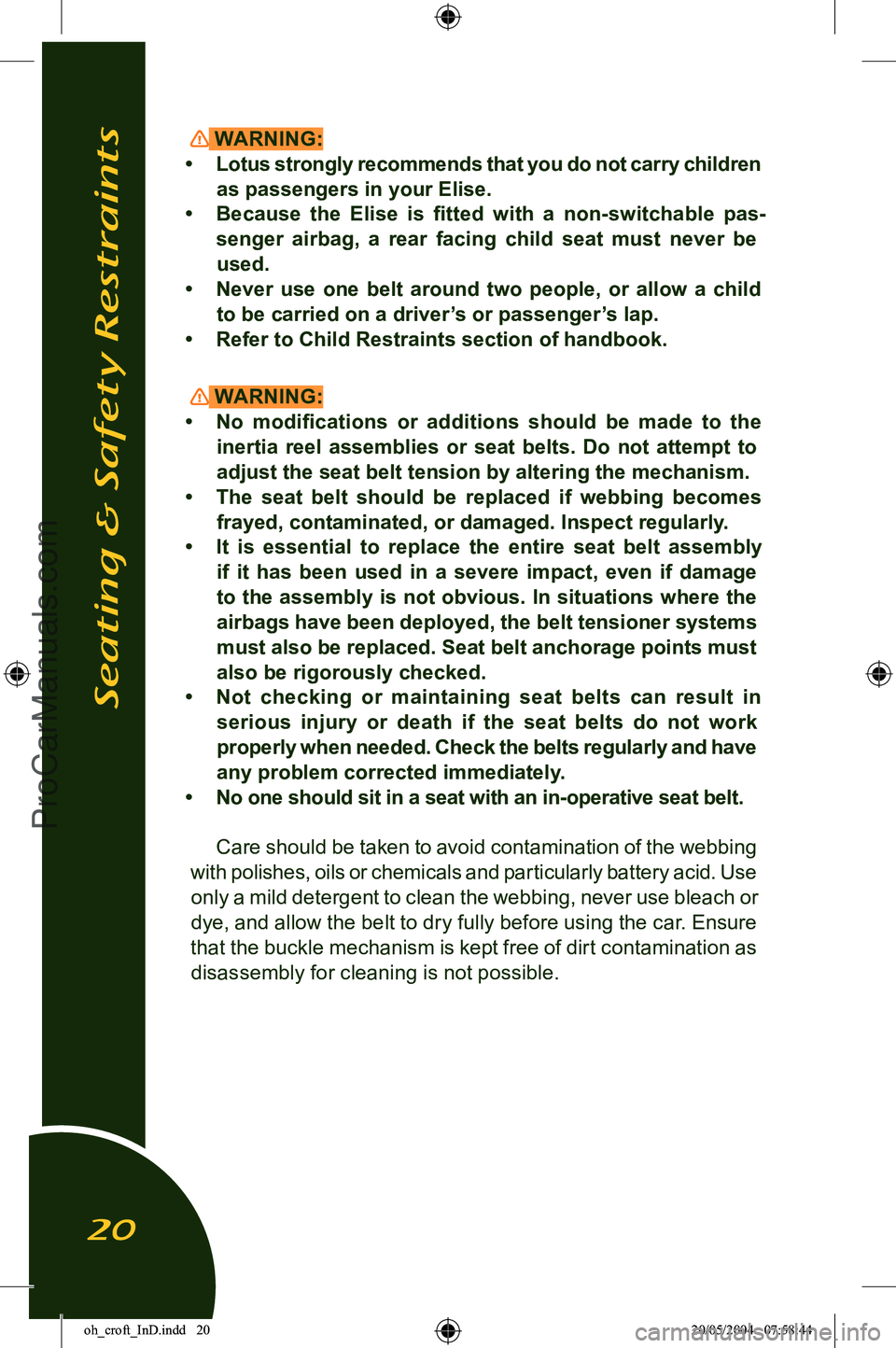
WARNING:
ā¢ Lotus strongly recommends that you do not carry children
as passengers in your Elise.
ā¢ Because the Elise is ļ¬tted with a non-switchable pas
-
senger airbag, a rear facing child seat must never be
used.
ā¢ Never use one belt around two people, or allow a child to be carried on a driverās or passengerās lap.
ā¢ Refer to Child Restraints section of handbook.
WARNING:
ā¢ No modiļ¬cations or additions should be made to the inertia reel assemblies or seat belts. Do not attempt to
adjust the seat belt tension by altering the mechanism.
ā¢ The seat belt should be replaced if webbing becomes frayed, contaminated, or damaged. Inspect regularly.
ā¢ It is essential to replace the entire seat belt assembly
if it has been used in a severe impact, even if damage
to the assembly is not obvious. In situations where the airbags have been deployed, the belt tensioner systems must also be replaced. Seat belt anchorage points must
also be rigorously checked.
ā¢ Not checking or maintaining seat belts can result in serious injury or death if the seat belts do not work
properly when needed. Check the belts regularly and have any problem corrected immediately.
ā¢ No one should sit in a seat with an in-operative seat belt.
Care should be taken to avoid contamination of the webbing
with polishes, oils or chemicals and particularly battery acid. Use
only a mild detergent to clean the webbing, never use bleach or
dye, and allow the belt to dry fully before using the car. Ensure
that the buckle mechanism is kept free of dirt contamination as disassembly for cleaning is not possible.Seating & Safety Restraints
20
oh_croft_InD.indd 2020/05/2004 07:58:44ProCarManuals.com
Page 25 of 205
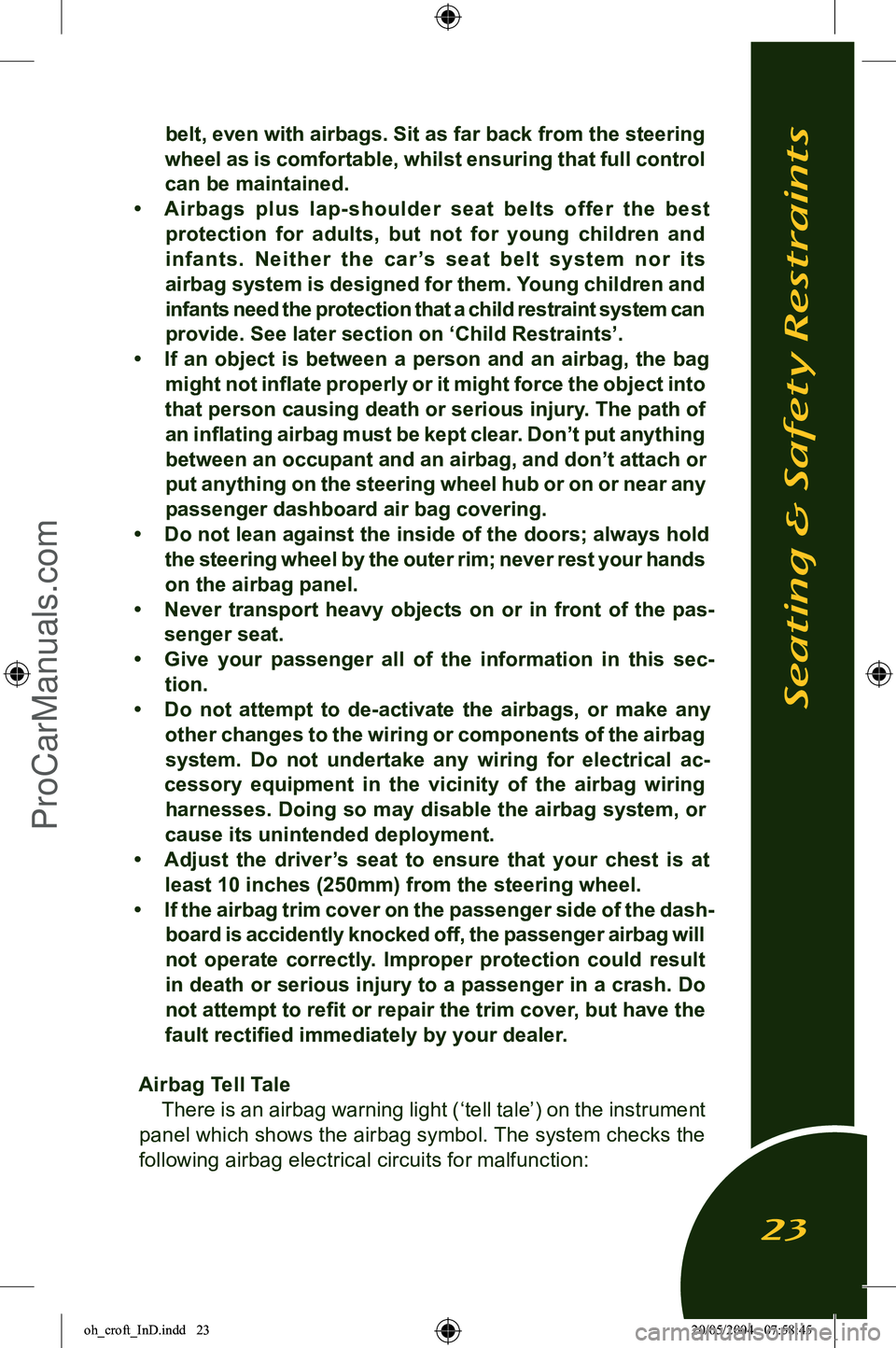
belt, even with airbags. Sit as far back from the steering
wheel as is comfortable, whilst ensuring that full control can be maintained.
ā¢ Airbags plus lap-shoulder seat belts offer the best protection for adults, but not for young children and
infants. Neither the car ās seat belt system nor its
airbag system is designed for them. Young children and
infants need the protection that a child restraint system can
provide. See later section on āChild Restraintsā.
ā¢ If an object is between a person and an airbag, the bag
might not inļ¬ate properly or it might force the object into
that person causing death or serious injury. The path of an inļ¬ating airbag must be kept clear. Donāt put anything between an occupant and an airbag, and donāt attach or
put anything on the steering wheel hub or on or near any
passenger dashboard air bag covering.
ā¢ Do not lean against the inside of the doors; always hold the steering wheel by the outer rim; never rest your hands
on the airbag panel.
ā¢ Never transport heavy objects on or in front of the pas
-
senger seat.
ā¢ Give your passenger all of the information in this sec
-
tion.
ā¢ Do not attempt to de-activate the airbags, or make any other changes to the wiring or components of the airbag
system. Do not undertake any wiring for electrical ac
-
cessory equipment in the vicinity of the airbag wiring harnesses. Doing so may disable the airbag system, or
cause its unintended deployment.
ā¢ Adjust the driverās seat to ensure that your chest is at
least 10 inches (250mm) from the steering wheel.
ā¢ If the airbag trim cover on the passenger side of the dash
-
board is accidently knocked off, the passenger airbag will
not operate correctly. Improper protection could result
in death or serious injury to a passenger in a crash. Do
not attempt to reļ¬t or repair the trim cover, but have the
fault rectiļ¬ed immediately by your dealer.
Airbag Tell Tale There is an airbag warning light (ātell taleā) on the instrument
panel which shows the airbag symbol. The system checks the
following airbag electrical circuits for malfunction:
Seating & Safety Restraints
23
oh_croft_InD.indd 2320/05/2004 07:58:45ProCarManuals.com
Page 26 of 205

ā¢ Drivers airbag circuit;
ā¢ Passenger airbag circuit;
ā¢ Seatbelts pre-tensioner circuit;
ā¢ Internal componentry of the sensor and diagnostic module.
As a bulb and circuit check, the tell tale will light brieļ¬y when
the ignition is switched on, and then go out. If the lamp lights at any other time, a fault in the airbag system is indicated, which
should be rectiļ¬ed without delay by your Lotus dealer.
WARNING: If the airbag tell tale does not light up as the ignition is
turned on, or remains lit for more than a few seconds, have
the fault rectiļ¬ed immediately by your dealer. Ignoring the
tell tale can result in serious injury or death if the airbags do not inļ¬ate when needed.
Airbag Deployment If a crash or collision causes the airbags to inļ¬ate, you may
see what looks like smoke, but is actually powder from the airbag
surface used to aid smooth deployment. Although the powder is not harmful, people with respiratory problems may experience
some temporary discomfort. If this occurs, get out of the car if possible as soon as it is safe to do so. After airbag deployment, the airbags, seat belt tensioners
and electronic control unit must be replaced by a Lotus dealer
or other suitably qualiļ¬ed organisation. Component parts of the airbag system are located in various
sites around the car. Any technician working on the car should be advised that the car is ļ¬tted with airbags to allow suitable
precautions to be taken.
WARNING:
ā¢ For up to 20 seconds after the ignition has been turned off and the battery disconnected, an airbag can still
inļ¬ate if improper servicing occurs. You can be injured
if you are close to an airbag when it inļ¬ates.
ā¢ Airbag system components should be serviced only by an authorised Lotus dealer. Do not work on the airbag
system yourself.
ā¢ The disposal of used airbag units is subject to stringent
Seating & Safety Restraints
24
oh_croft_InD.indd 2420/05/2004 07:58:45ProCarManuals.com